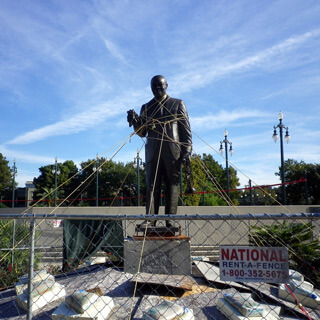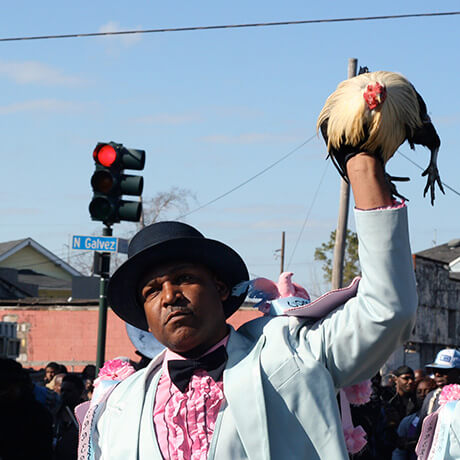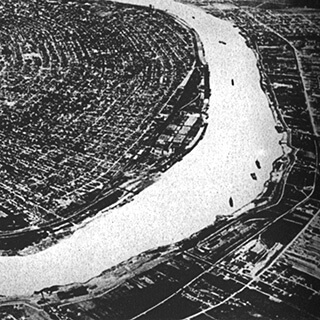Overview
Katherine Mooney reviews The Accidental City: Improvising New Orleans (Cambridge, MA: Harvard University Press, 2012) by Lawrence N. Powell.
Review
 |
In the acknowledgements for The Accidental City, Lawrence N. Powell remembers that, after Hurricane Katrina, pundits asked why New Orleans should be rebuilt, when its site was clearly untenable for human habitation. Those questions about his longtime hometown hurt, he admits, but he decided to respond to them constructively. He would explore why New Orleans had been built in its present location. His answer is a fairly simple one. No one ever claimed that the site was ideal or even propitious for a city. Bienville and his cohorts only built there because they had already claimed land concessions in the area. Powell’s book chronicles the town’s history from the time of Bienville to the Battle of New Orleans, explaining how this “accidental city” became one of the most significant urban areas in the Americas.
From the beginning, the city’s location caused headaches. After disastrous flooding in 1719, Bienville quickly threw up the first levees. No one had bothered before the floods, Powell dryly points out. “But this was how things went in New Orleans before New Orleans officially became New Orleans, and long afterward, too: solutions to foreseeable problems usually surfaced as afterthoughts” (49–50). Powell sees his hometown with bemused clarity. He largely avoids the traps of romanticizing his subject’s glamour or moralizing over its ugliness, two common pitfalls for anyone writing about New Orleans.
 |
| Maunsel White, Map 1814–1815 New Orleans, 1815. From Library of Congress Map Collections, 2007627049. |
The Mississippi River flows throughout The Accidental City. The river appealed to empire builders as an artery that could connect North America from Canada to the Gulf of Mexico. New Orleans provided warehouses to store the river’s goods, businessmen to buy and sell them, and captains to transport them. Powell gives vivid portraits of the different visions of empire that played out in the Mississippi Valley. The French relied on an itinerant population and relationships with powerful Native groups, while the Spanish and British constructed more closely regimented landscapes. Powell explains the varying roles that European powers imagined New Orleans playing in North America. The French envisioned its commercial importance while Spanish planned to use New Orleans as a buffer between New Spain and British America, even as the city voraciously consumed British goods. Meanwhile, Powell traces the rise of a creole elite and its efforts to secure power under a succession of colonial governments. But Powell keeps his story anchored in the city itself, in the grid of streets that French engineers hoped would foster civic virtue and in the persistent spaces usually known in New Orleans as “back of town,” the haunts of runaway slaves, prostitutes, and smugglers.
 |
| Plan de Nouvelle Orleans, 1722. From Library of Congress Map Collections, 2003623130. |
 |
| Tomás López de Vargas Machuca, Plano de la Nueva Orleans, from La Luisiana cedida al Rei N. S. por S. M. Christianisima, 1762. From Library of Congress Map Collections, 74692110. |
 |
| Thomas Jefferys, Plan of New Orleans, the capital of Louisiana, 1759. From Library of Congress Map Collections, 74692199. |
Powell consistently reminds his readers of the proximity of front and back, the sheer lack of space in which people could live in New Orleans in the eighteenth century. Though topography dictated many of the choices New Orleanians made about their city, he argues, the people making the choices were a mixture of Europeans, African and creole slaves, free blacks, and Native Americans. These groups lived together in New Orleans from the time of its founding, and much of his story is devoted to the details and consequences of their relationships. Building on Ira Berlin’s work, Powell depicts what the region’s shift away from cash crop monoculture in the eighteenth century actually consisted of and what that change’s consequences were for slaves in New Orleans. He then chronicles the reemergence of plantation agriculture in the wake of the Haitian Revolution and the impact of sugar production, as it brought waves of African arrivals and a deadly new form of bondage to established creole communities. Powell incisively argues that it was the new American regime’s eagerness to serve the interests of slaveholders that made Louisiana elites staunch supporters of the United States. He also gives particular attention to the role of Spanish colonial policies on manumission, self-purchase, and militia service in creating New Orleans’s unique caste of free people of color. His depiction of their struggles to carve out lives for themselves and their children is sensitive to their difficult negotiation of the social space between white elites and black slaves.
In his discussion of the complex racial realities of early New Orleans and, indeed, in his work as a whole, Powell builds on the formidable efforts of previous historians like Berlin, Shannon Dawdy, and Caryn Cossé Bell, to name only a few. Powell’s project is largely a well-written synthesis of a wide variety of secondary sources on this always engaging and evolving topic. His work is welcome in its ability to open up, both for academic and general readers, a historiography that can be as dauntingly complicated as the place it examines. Powell’s prose deftly untangles difficult issues. He lucidly explicates peripheral topics, and his knack for the lightning character sketch is much in evidence, as he marshals a colorful cast of characters. On only a few occasions does Powell’s passion for his subject lead him to lyrical overstatement about the “lineages of three continents . . . forced to crowd together . . . and somehow learn to improvise a coexistence whose legacy may be America’s only original contribution to world culture” (163).
In an epilogue, Powell touches on Mardi Gras, New Orleans’s quintessential event, briefly contrasting elite visions of an orderly ritual of power with the cheerful anarchy of carnival in the street. The contrast, he suggests, is of the sort that New Orleans has sustained since its beginning, when colonial planters measured municipal blueprints and crowds rubbed shoulders on corners and in bars and in the end made a city in their own image. The important thing, Powell implies, is not where New Orleans was born, but how and why it has survived and what it may yet become. 
Recommended Resources
Bell, Caryn Cossé. Revolution, Romanticism, and the Afro-Creole Protest Tradition in Louisiana, 1718–1868. Baton Rouge: Louisiana State University Press, 1997.
Berlin, Ira. Many Thousands Gone: The First Two Centuries of Slavery in North America. Cambridge, MA: Harvard University Press, 1998.
Dawdy, Shannon Lee. Building the Devil’s Empire: French Colonial New Orleans. Chicago: University of Chicago Press, 2008.



